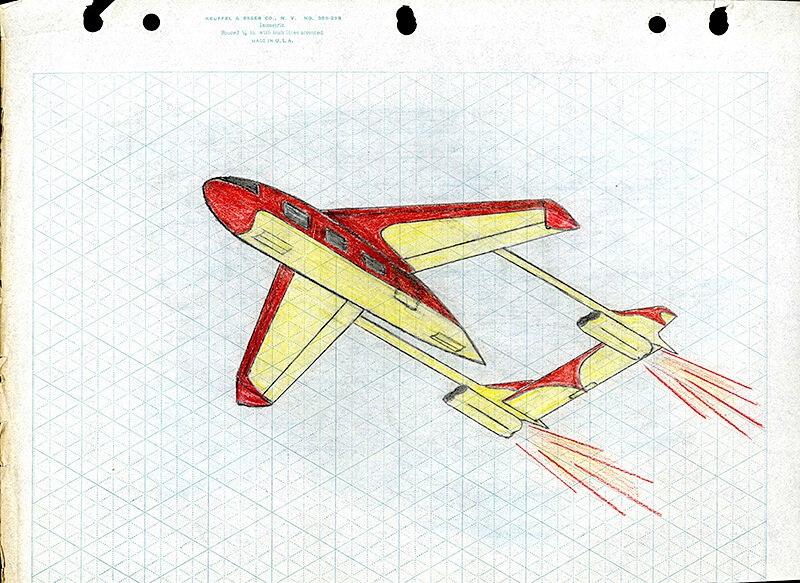September 26, 2018
Personal papers from ‘First Man’ Neil Armstrong’s giant leap into history have landing spot at Purdue, his alma mater
 Student design sketch for Purdue University course project: “Preliminary Design Analysis Executive Transport report” by Neil Armstrong for the course A.E. 420, January 1955. (Neil A. Armstrong papers, Courtesy of Purdue University Archives)
Student design sketch for Purdue University course project: “Preliminary Design Analysis Executive Transport report” by Neil Armstrong for the course A.E. 420, January 1955. (Neil A. Armstrong papers, Courtesy of Purdue University Archives)
WEST LAFAYETTE, Ind. — While the excitement builds around the new Neil Armstrong biopic, much of the “First Man” on the moon’s life story is preserved and treasured at his alma mater.
Purdue University is home to hundreds of thousands of personal documents, working papers, memorabilia and photos from the 1955 graduate’s life. The collection includes approximately 70,000 pages of fan mail, which Armstrong continued to receive from around the world for years after he landed on the moon; his Purdue student notebooks and project reports; speech manuscripts; and NASA missions training, execution and results documents. These materials are available for scholarship and learning at Purdue Libraries’ Division of Archives and Special Collections.
Other personal items include:
* Purdue, Navy training and NASA photographs.
* Gemini 8 space food, toothbrush, motion sickness medicine, navigation aids and more.
* Apollo 11 lunar maps, checklists and manuals.
* Apollo 11 World Tour documents and photographs.
* Model planes.
Because of Armstrong’s moon landing and his legacy, Giant Leaps is the name of Purdue’s Sesquicentennial campaign. The year will highlight Purdue’s remarkable history of giant leaps, while focusing on what giant leaps the university can take to address the world’s problems.
Sammie Morris, professor and head of the Purdue Libraries’ Division of Archives and Special Collections, says Armstrong and his wife, Carol, specifically chose to donate the collection to his alma mater so scholars and students can access them for research. The Armstrong collection also contains hundreds of personal working papers from his time at NASA and artifacts from his missions. Armstrong donated part of the collection in 2008, and his widow, Carol Armstrong, donated the rest after his death in 2012.
“The collection as a whole provides a context for his personal role in the U.S. space program that is as close to firsthand as you can get,” says Tracy Grimm, associate head of Archives and Special Collections and the Barron Hilton Archivist for Flight and Space Exploration. “Although a major motion picture may dramatize and make portrayals of famous individuals such as Neil, it’s really only in personal papers where one can learn who that person really was and how they accomplished what they did.” Grimm noted that Purdue Archives also holds the papers of James Hansen, Neil Armstrong’s official biographer and author of “First Man.”
The collection has been preserved, arranged, and cataloged so it can be easily accessed for research and learning use. There is a 364 page finding guide to the collection. Researchers interested in accessing the collection should make an appointment with Grimm by email.
The public will be able to view numerous Armstrong documents and items during two 2019 exhibits. The exhibits are:
* The Purdue Archives and Special Collections will present “Apollo 11 in the Archives: Selections from the Neil A. Armstrong Papers,” March 18 to Aug. 16, 2019 in the Humanities, Social Science, and Education (HSSE) Library, 4th floor.
* Purdue’s Ringel Gallery in partnership with Archives and Special Collections will present the exhibit “Return to Entry,”which will feature artwork inspired by Armstrong’s archival collection, March 25 to May 11, 2019, in the Ringel Gallery, Stewart Center.
Writer: Abbey Nickel, 765-496-1325, nickela@purdue.edu
Sources: Tracy Grimm, associate head of Archives and Special Collections, grimm3@purdue.edu,
Sammie Morris, head of Archives and Special Collections, morris18@purdue.edu

